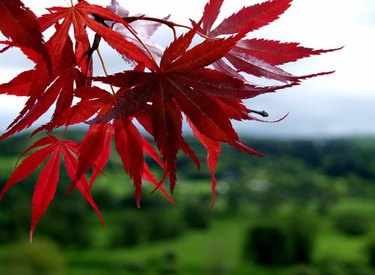Things You'll Need
Pruning shears
Hose
Fungicide (optional)
Soil fumigant (optional)

The Japanese red maple is a popular and attractive ornamental tree. It is a small, showy tree, reaching heights up to 20 feet. Its reddish-purple leaves provide stunning color both in the spring and in the fall when the leaves will turn a brilliant red color. The Japanese red maple prefers well-drained soils. It does best in full sun, but will tolerate partial shade. A tree not leafing out is an indication that it is stressed. The stress can be caused by any number of factors. An examination of the tree and its leaves will help you troubleshoot the problem.
Step 1
Examine the leaves that are present for evidence of scorching. Scorching will appear as yellowing around the margins of leaves. There is not a definite cause of scorching. Rather, it is an indication that conditions are not suitable for the tree. Under these circumstances, a Japanese red maple will not leaf out. Continue to troubleshoot to identify the unfavorable conditions.
Video of the Day
Step 2
Test your soil. Test kits are available from your garden center. Alternatively, your agricultural extension office may also perform soil testing for a nominal fee.
Step 3
Amend the soil as necessary. The Japanese red maple prefers slightly acidic soils. You can lower the pH by adding organic material such as peat moss to the soil.
Step 4
Check the moisture content of the soil. Grab a handful of soil in your hand and squeeze your hand shut. When you open your hand again, the soil should be slightly compacted into a ball shape. If the soil is powdery, conditions may be too dry for the tree.
Step 5
Water your tree thoroughly if the soils are too dry. While it has some drought resistance, the Japanese red maple generally prefers moist soil conditions. If dry conditions prevail, photosynthesis, the process by which plants make food and energy, slows. This slowing in turn will slow new leaf growth.
Step 6
Examine the twigs and limbs for black streaking. Like scorching, browning of leaf margins may also be present. These symptoms together indicate the fungal disease Verticillium. Verticillium is a soil fungus. It can cause dieback of shoots, preventing the tree from leafing out. Unfortunately, it is difficult to treat.
Step 7
Apply a soil fumigant available from your garden center only if the garden covers a small area. If the tree is not severely infected, maintain the tree properly, with adequate water and a high potassium and low nitrogen fertilizer, and the tree may recover on its own.
Step 8
Look for patches of gray mold on the tree. The presence of gray mold can indicate the fungal disease, botrytis. It is a serious condition that requires prompt treatment.
Step 9
Prune the tree to improve air circulation. Remove any dead twigs or branches. Properly dispose of any cuttings to prevent re-infection. Apply a general fungicide to control the fungus.
Tip
Avoid fungal disease by watering early in the day rather than later so that the trees have enough time to dry.
Warning
Always sterilize pruning shears between cuttings with a mild chlorine bleach solution or rubbing alcohol when treating for a disease to prevent affecting other plants.
Video of the Day